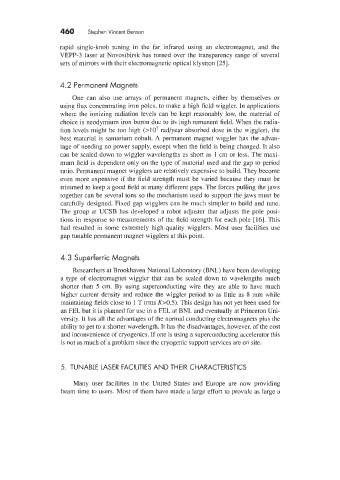Page 500 - Tunable Lasers Handbook
P. 500
460 Stephen Vincent Benson
rapid single-knob tuning in the far infrared using an electromagnet, and the
VEPP-3 laser at Novosibirsk has turned over the transparency range of several
sets of mirrors with their electromagnetic optical klystron [25].
4.2 Permanent Magnets
One can also use arrays of permanent magnets, either by themselves or
using flux concentrating iron poles, to make a high field wiggler. In applications
where the ionizing radiation levels can be kept reasonably low, the material of
choice is neodymium iron boron due to its high remanent field. When the radia-
tion levels might be too high (>IO7 rad/year absorbed dose in the wiggler), the
best material is samarium cobalt. A permanent magnet wiggler has the advan-
tage of needing no power supply, except when the field is being changed. It also
can be scaled down to wiggler wavelengths as short as 1 cm or less. The maxi-
mum field is dependent only on the type of material used and the gap to period
ratio. Permanent magnet wigglers are relatively expensive to build. They become
even more expensive if the field strength must be varied because they must be
trimmed to keep a good field at many different gaps. The forces pulling the jaws
together can be several tons so the mechanism used to support the jaws must be
carefully designed. Fixed gap wigglers can be much simpler to build and tune.
The group at UCSB has developed a robot adjuster that adjusts the pole posi-
tions in response to measurements of the field strength for each pole [16]. This
had resulted in some extremely high-quality wigglers. Most user facilities use
gap tunable permanent magnet wigglers at this point.
4.3 Superferric Magnets
Researchers at Brookhaven National Laboratory (BNL) have been developing
a type of electromagnet wiggler that can be scaled down to wavelengths much
shorter than 5 cm. By using superconducting wire they are able to have much
higher current density and reduce the wiggler period to as little as 8 mrn while
maintaining fields close to 1 T (rms K>0.5). This design has not yet been used for
an FEL but it is planned for use in a FEL at BNL and eventually at Princeton Uni-
versity. It has all the advantages of the normal conducting electromagnets plus the
ability to get to a shorter wavelength. It has the disadvantages, however, of the cost
and inconvenience of cryogenics. If one is using a superconducting accelerator this
is not as much of a problem since the cryogenic support services are on site.
5. TUNABLE LASER FACILITIES AND THEIR CHARACTERISTICS
Many user facilities in the United States and Europe are now providing
beam time to users. Most of them have made a large effort to provide as large a

